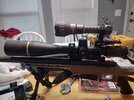Just disasembled my Ruger hawkeye base and getting ready to clean/reinstall it and a Masterpiece arms 34mm one-piece mount. Ive been using blue loctite most of my life but Ive heard some now saying that purple, green and yes.......even RED loctite are better for these applications because of the violence recoil entails. This is on a fairly heavy (roughly 15-16lbs) 6.5 PRC with a muzzle break. Sounds like my ex wife when she didnt get her way when it goes off but the recoil is honestly not bad at all. But theres still that Ex wife-ish concusion from the blast. Is there a better option than blue loctite? Are these others better suited or maybe even somthing else? Stick with the blue? I shoot quite a bit of long range and prefer my stuff to stay as solid as possible.
Thanks,
Kevin
Thanks,
Kevin



